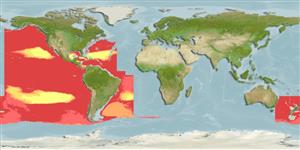分類 / Names
俗名 | 同種異名 | Catalog of Fishes(屬, 種) | ITIS | CoL | WoRMS | Cloffa
Teleostei >
Lophiiformes (Anglerfishes)
鮟鱇目 (Anglerfishes) >
Gigantactinidae (Whipnose anglers)
大角鮟鱇科 (Whipnose anglers)
Etymology: Gigantactis: Greek, 'gigas' or 'gigantos' = gigantic + Greek, 'aktis' = ray (referring to the unusually long first dorsal-fin spine that functions as a lure in this genus) (Ref. 86949).
More on author: Regan.
Environment: milieu / climate zone / depth range / distribution range
生態學
海洋 深海區的; 深度上下限 650 - 2500 m (Ref. 86949). 深水域
Atlantic Ocean and Pacific Ocean.
對西南大西洋 , 與東北太平洋的中央及東部。
大小 / 重量 / 年齡
Maturity: Lm ? range ? - ? cm
Max length : 11.7 cm SL 雄魚/尚未辨別雌雄; (Ref. 13608); 35.4 cm SL (female)
背棘 (總數): 0; 背的軟條 (總數): 5-6; 臀棘 0; 臀鰭軟條: 5 - 6. Metamorphosed females distinguished by the following characteristics: length of illicium 340-447% SL; escal bulb with lightly pigmented truncated distal prolongation; 6-20 long distal filaments; escal papillae absent; proximal escal papillae absent; short dentary teeth (longest 1.3-3.4% SL, average 2.3% SL), arranged posteriorly in two longitudinal series; length of caudal fin rays less than 45% SL; weakly developed skin coverage of proximal part of caudal fin; caudal fin rays free nearly to base (Ref. 86949).
誘餌的長度 340-447% SL; 被截形的餌球的末梢部延伸, 生長著排列成幾乎對稱的對 8-20個長的末梢部的附肢。 (參考文獻 41361) 尾鰭的第二與第 7 鰭條不非常地延長。 (參考文獻 13608)
Appear to be active predators which feed on midwater fishes, including Cyclothone acclinidens, Triphoturus mexicanus and Bathylagus stilbius; cephalopods like Vampyroteuthis; and various invertebrates like amphipods, natant decapod crustaceans and coelenterates (Ref. 4525). Maximum length for female from Ref. 41361.
吃中層水域魚的似乎活躍的掠食者, 包括 Cyclothone acclinidens , 墨西哥尾燈魚〔Triphoturus mexicanus〕 與 滑舌深海鮭〔Bathylagus stilbius〕 ; 頭足類動物例如 Vampyroteuthis; 而且各種不同的無脊椎動物類似片腳類動物,浮在水上的十足目的甲殼動物與腔腸動物.(參考文獻 4525) 最大的母魚體長從參考文獻 41361.
Life cycle and mating behavior
成熟度 | 繁殖 | 產卵場 | 卵 | 孕卵數 | 仔魚
對西南大西洋 , 與東北太平洋的中央及東部。
Uyeno, T., K. Matsuura and E. Fujii (eds.), 1983. Fishes trawled off Suriname and French Guiana. Japan Marine Fishery Resource Research Center, Tokyo, Japan. 519 p. (Ref. 13608)
人類使用
更多資訊
俗名同種異名新陳代謝捕食者生態毒物學繁殖成熟度產卵場產卵群集孕卵數卵卵發育
參考文獻養殖養殖資訊品種遺傳學Electrophoreses遺傳率疾病加工NutrientsMass conversion
合作者照片Stamps, Coins Misc.聲音神經毒速度泳型鰓區Otoliths腦重體重比眼睛色素
工具
特別的報告
下載 XML
網路資源
Estimates based on models
Preferred temperature (Ref.
123201): 2.4 - 5.6, mean 4.3 °C (based on 372 cells).
Phylogenetic diversity index (Ref.
82804): PD
50 = 0.5000 [Uniqueness, from 0.5 = low to 2.0 = high].
Bayesian length-weight: a=0.01995 (0.00906 - 0.04395), b=3.01 (2.83 - 3.19), in cm total length, based on all LWR estimates for this body shape (Ref.
93245).
營養階層 (Ref.
69278): 4.0 ±0.61 se; based on food items.
Fishing Vulnerability (Ref.
59153): Low to moderate vulnerability (33 of 100).
